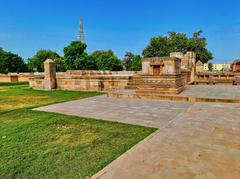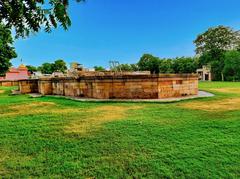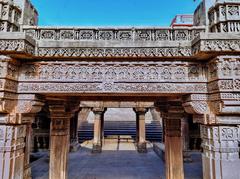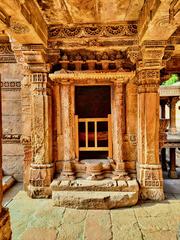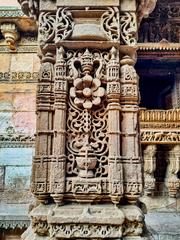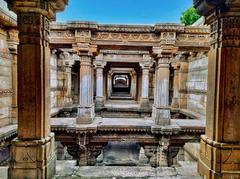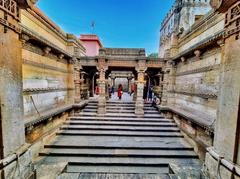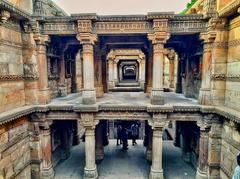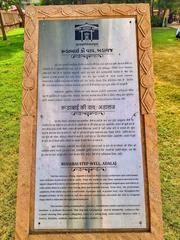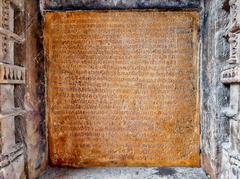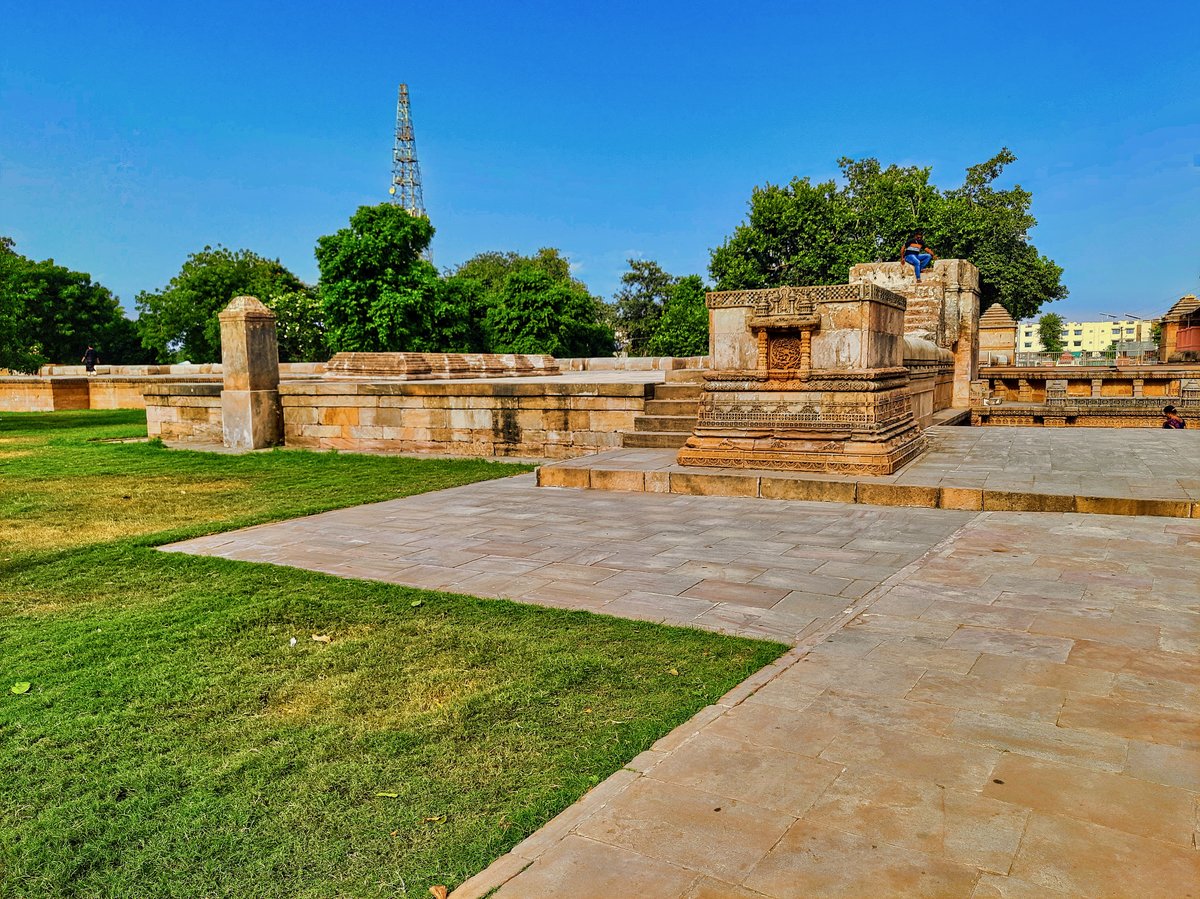
Visiting Adalaj Stepwell in Kalol, India: Hours, Tickets, History, and Tips
Date: 16/08/2024
Introduction
The Adalaj Stepwell, also known as Adalaj ni Vav, stands as a testament to the architectural ingenuity and cultural richness of ancient India. Located in the small town of Adalaj, near Gandhinagar in Gujarat, India, this historical monument was commissioned in 1498 AD by Queen Rudabai, the wife of Rana Veer Singh of the Vaghela dynasty. The stepwell’s creation is deeply intertwined with the region’s tumultuous history, having been completed under the rule of Mahmud Begada, the Sultan of Gujarat, after the death of Rana Veer Singh (Wikipedia).
This five-story deep marvel is not just an engineering feat but also a blend of Indian and Islamic architectural styles. Intricate carvings and detailed stonework adorn the structure, depicting scenes from mythology, daily life, and floral patterns. The stepwell serves multiple purposes: a water reservoir, a social and cultural hub, and a spiritual refuge (FootLoose Dev). Its ability to provide cool respite in the scorching summer months made it a vital gathering place for locals and travelers alike (Atlas Obscura).
As you plan your visit to this historical site, this comprehensive guide will provide you with essential information, including visiting hours, ticket prices, travel tips, and nearby attractions. Whether you’re an architecture enthusiast, a history buff, or someone looking to experience the serene beauty of this ancient marvel, the Adalaj Stepwell promises an unforgettable journey into the past.
Table of Contents
- Introduction
- History and Significance
- Architectural Significance
- Cultural and Spiritual Significance
- Preservation and Tourism
- Conclusion
- FAQ
- References
History and Significance
Historical Background
The Adalaj Stepwell is a remarkable example of ancient Indian architecture and engineering. Located in the small town of Adalaj, near Gandhinagar in Gujarat, India, this stepwell was constructed in 1498 AD. The stepwell was commissioned by Queen Rudabai, the wife of Rana Veer Singh of the Vaghela dynasty, in memory of her late husband (Wikipedia).
The construction of the stepwell began under the rule of Rana Veer Singh, but he was killed in a battle against Mahmud Begada, the Sultan of Gujarat. After the death of Rana Veer Singh, Mahmud Begada took over the region and completed the construction of the stepwell. Despite the change in rulers, the stepwell is named after Queen Rudabai, who played a significant role in its creation (Thrilling Travel).
Architectural Significance
Design and Structure
The Adalaj Stepwell is an architectural marvel, showcasing a blend of Indian and Islamic styles. Built using sandstone, the stepwell is five stories deep and features intricate carvings and detailed stonework. The structure is octagonal at the top and supported by a large number of intricately carved pillars. Each floor of the stepwell is spacious enough to accommodate gatherings, making it not just a water reservoir but also a social and cultural hub (FootLoose Dev).
The carvings on the walls and pillars depict various scenes from mythology, daily life, and floral patterns. One of the most interesting carvings is that of elephants, each with unique designs. The motifs of flowers represent Islamic influence, while the symbols of Hindu and Jain gods reflect the secular nature of the stepwell (FootLoose Dev).
Functional Aspects
The stepwell was designed to provide water to the arid regions of Gujarat and served as a resting place for travelers and pilgrims. The central shaft of the stepwell allows light and air to reach the lower levels, creating a cool and serene environment even during the scorching summer months. The temperature inside the well is about five degrees lower than the outside temperature, making it a popular spot for locals to gather and socialize (Wikipedia).
The stepwell features three sets of entrance stairs, which all meet on the first level down at a large square platform. This unique design allows for efficient movement of people and ensures that the well remains cool and well-ventilated. The air and light vents in the roofs at various floors and the landing level are in the form of large openings, allowing for natural ventilation and lighting (Atlas Obscura).
Cultural and Spiritual Significance
Symbolism and Legends
The Adalaj Stepwell holds immense cultural and spiritual significance. It was not only a water reservoir but also a place for social gatherings, religious ceremonies, and festivals. According to local folklore, Rana Veer Singh began the construction of the stepwell to alleviate the water scarcity in his kingdom. However, after his defeat by Mohammed Begda, the Muslim ruler completed the project. It is said that Begda was so impressed by the beauty of the stepwell that he allowed the Hindu artisans to continue their work, resulting in a unique blend of Hindu and Islamic architectural elements (Tripoto).
Religious and Social Importance
The stepwell also holds religious significance, as it features numerous carvings of Hindu deities and symbols. It served as a place of worship and meditation for the local community. The stepwell’s cool and serene environment provided a perfect setting for spiritual and social gatherings, making it an integral part of the community’s cultural fabric (Travelsetu).
Preservation and Tourism
Visiting Hours
The Adalaj Stepwell is open to visitors from 6 am to 6 pm every day. The best time to visit is in the first half of the day when the sunlight enhances the gorgeous carvings (Thrilling Travel).
Ticket Prices
The entry fee for visiting the stepwell is INR 20 per person for Indian nationals, with additional charges for cameras. For foreign nationals, the entry fee is INR 300. Visitors can explore the intricate architecture, learn about the history of the stepwell through inscriptions and plaques, and enjoy the serene surroundings (Atlas Obscura).
Best Time to Visit
To make the most of your visit, aim to arrive early in the morning or late afternoon. This timing ensures you avoid the midday heat and allows you to appreciate the stepwell’s beauty in favorable lighting conditions.
Travel Tips and Nearby Attractions
When planning your visit, consider combining your trip to Adalaj Stepwell with other nearby historical sites in Gandhinagar. Ensure you carry sufficient water, wear comfortable shoes, and bring a hat or umbrella to shield yourself from the sun.
Special Events and Guided Tours
The Adalaj Stepwell occasionally hosts cultural events and festivals, providing a unique opportunity to experience the site in a different light. Guided tours are available, offering deeper insights into the history and significance of the stepwell.
Conclusion
The Adalaj Stepwell is a testament to the ingenuity and artistic excellence of ancient India. Its historical significance, architectural beauty, and cultural importance make it a must-visit destination. Whether you are a history buff, an architecture enthusiast, or simply looking for a serene and fascinating place to visit, the Adalaj Stepwell offers an unforgettable experience. Plan your visit to explore its intricate carvings, learn about its rich history, and immerse yourself in the beauty of this ancient marvel (eIndiaTourism).
FAQ
What are the Adalaj Stepwell visiting hours?
The Adalaj Stepwell is open from 6 am to 6 pm every day.
How much are tickets for Adalaj Stepwell?
The entry fee is INR 20 for Indian nationals and INR 300 for foreign nationals, with additional charges for cameras.
What is the best time to visit Adalaj Stepwell?
The best time to visit is early in the morning or late afternoon to avoid the midday heat and enjoy the lighting conditions.
